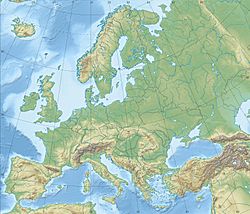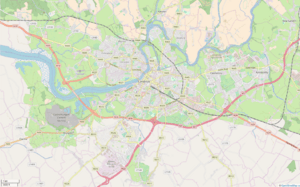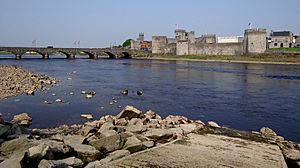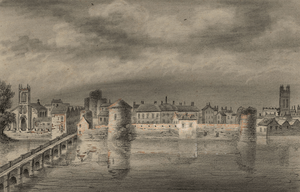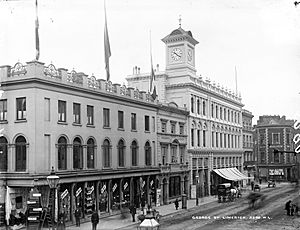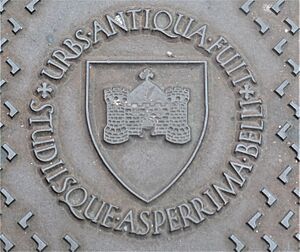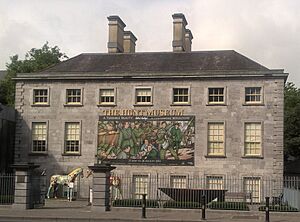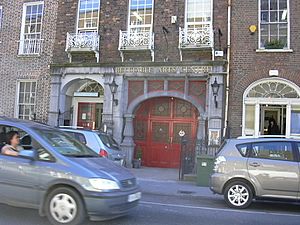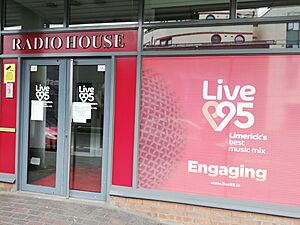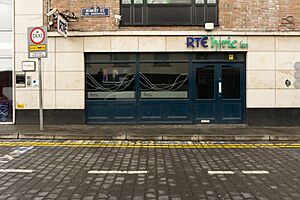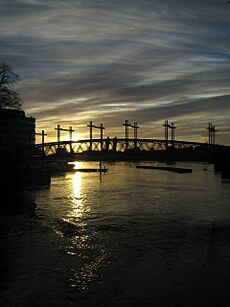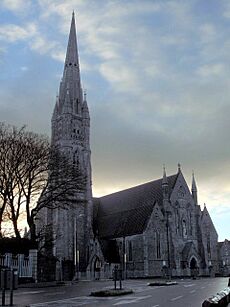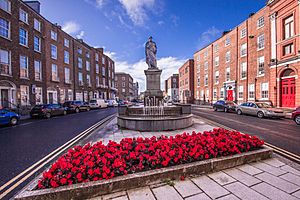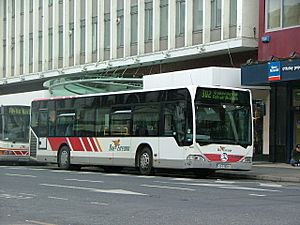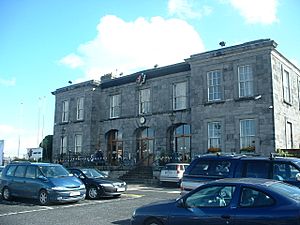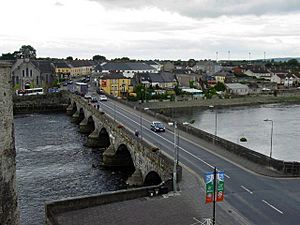Limerick facts for kids
Quick facts for kids
Limerick
Luimneach
|
||
|---|---|---|
|
City
|
||
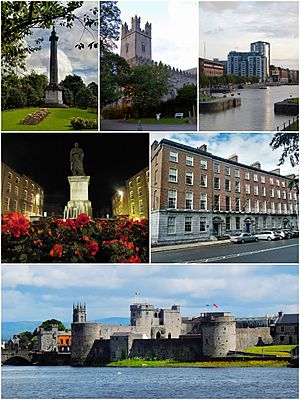
From top, left to right: People's Park, St. Mary's Cathedral, Riverpoint, Daniel O'Connell Monument, Georgian architecture at Pery Square, King John's Castle
|
||
|
||
| Nickname(s):
The Treaty City, Shannonside
|
||
| Motto(s):
Latin: Urbs Antiqua Fuit
Studiisque Asperrima Belli "There was an ancient city very fierce in the skills of war" |
||
| Country | Ireland | |
| Province | Munster | |
| Region | Southern (Mid-West) | |
| County | Limerick | |
| Founded | 812 AD | |
| City Rights | 1197 AD | |
| Area | ||
| • Total | 61.3 km2 (23.7 sq mi) | |
| Elevation | 10 m (30 ft) | |
| Population
(2022)
|
||
| • Total | 102,287 | |
| • Rank | 3rd | |
| • Density | 1,669/km2 (4,320/sq mi) | |
| • Metro | 162,413 | |
| Demonyms | Limerickman, Shannonsider, Treatyman |
|
| Time zone | UTC0 (WET) | |
| • Summer (DST) | UTC+1 (IST) | |
| Eircode Routing Key |
V94
|
|
| Telephone Area Code | 061(+353 61) | |
| Vehicle Index Mark Code |
L | |
Limerick (pronounced LIM-ər-ik; in Irish: Luimneach) is a city in western Ireland. It is part of County Limerick and is located in the province of Munster. With over 102,000 people living there in 2022, Limerick is the third-largest city in Ireland. It was first settled by Viking explorers in 812 AD.
The city is built along the River Shannon. Its oldest part, King's Island, is surrounded by the Shannon and Abbey Rivers. Limerick is at the start of the Shannon Estuary, where the river gets wider before it flows into the Atlantic Ocean. The city is managed by the Limerick City and County Council.
Contents
- Exploring Limerick's Location
- Limerick's Past: A Journey Through Time
- Limerick's People: A Diverse Community
- Limerick's Weather: A Mild Climate
- Limerick's Culture and Arts Scene
- Limerick's Humorous Verse
- Media in Limerick
- Interesting Places to Visit in Limerick
- Limerick's Economy and Business
- Getting Around Limerick: Transport Options
- Learning in Limerick: Education Centers
- Sports in Limerick: A City of Champions
- Limerick's Sister Cities
- Images for kids
- See also
Exploring Limerick's Location
Limerick is right on the River Shannon, with four main bridges in the city center. South of the city is the Golden Vale, a very fertile area with rich pastureland. In the past, many of Limerick's businesses used products from this farming region.
In 2014, the city and county of Limerick joined together to form one local council. A new area called the Metropolitan District of Limerick was created. This district includes the city and stretches out towards Patrickswell in the west and Castleconnell in the east.
Limerick's Past: A Journey Through Time
Early Days and Medieval Times
The name Luimneach originally meant the area along the Shannon Estuary. The first settlement on King's Island was called Inis Sibhtonn before and during the Viking era. The Vikings arrived in 812 AD and attacked the city.
Maps from ancient times, like one made by Ptolemy in 150 AD, show a place called Regia where King's Island is today. This suggests people lived here long ago. Saint Patrick visited in 434 AD. Saint Munchin, Limerick's first bishop, died in 652 AD, showing it was an important place even then.
In the 12th century, the Normans rebuilt the city. They added famous buildings like King John's Castle and St Mary's Cathedral. In medieval times, Limerick was the center of the Kingdom of Thomond. This kingdom covered parts of present-day County Clare and County Kerry. A famous king from this area was Brian Boru.
Later History and the Treaty City
In the 1600s, Limerick was known as a very beautiful city. During the wars of the 17th century, the city was attacked many times. The Treaty of Limerick in the 1690s ended a major war in Ireland. This treaty offered some religious freedom to Catholics. It was signed on the Treaty Stone, which you can still see today. Because of this treaty, Limerick is often called The Treaty City.
After these wars, Limerick became a busy trading port in the late 1700s. It exported farm products from the fertile Golden Vale to Britain and America. This trade made the city rich, and Georgian Limerick was built. This area has beautiful Georgian houses that you can still see in the city center.
The Waterford and Limerick Railway connected Limerick to other cities in the mid-1800s. However, economic problems and the Great Irish Famine in the 1840s made the 19th century a difficult time for the city.
Limerick in the 20th Century
In the early 1900s, there was a difficult period for the small Jewish community in Limerick. Some people were treated unfairly, and many Jewish families left the city.
During the Irish War of Independence, Limerick had a unique event called the Limerick Soviet in 1919. Workers went on strike to protest military rules. They even printed their own money and controlled food prices for a short time.
By the mid-1900s, many old industries in Limerick closed. However, new developments brought hope. Shannon Airport opened in 1942, offering flights across the Atlantic. In 1959, the Shannon Free Zone was created, attracting many international companies. A university, the University of Limerick, was also established in 1989, which helped the city grow.
Limerick's People: A Diverse Community
| Historical population | ||
|---|---|---|
| Year | Pop. | ±% |
| 1659 | 3,105 | — |
| 1821 | 59,045 | +1801.6% |
| 1831 | 66,554 | +12.7% |
| 1841 | 48,391 | −27.3% |
| 1851 | 48,785 | +0.8% |
| 1861 | 43,924 | −10.0% |
| 1871 | 39,353 | −10.4% |
| 1881 | 38,562 | −2.0% |
| 1891 | 37,155 | −3.6% |
| 1901 | 38,151 | +2.7% |
| 1911 | 38,518 | +1.0% |
| 1926 | 39,448 | +2.4% |
| 1936 | 41,061 | +4.1% |
| 1946 | 42,970 | +4.6% |
| 1951 | 50,820 | +18.3% |
| 1956 | 51,666 | +1.7% |
| 1961 | 51,732 | +0.1% |
| 1966 | 58,082 | +12.3% |
| 1971 | 57,161 | −1.6% |
| 1979 | 60,665 | +6.1% |
| 1981 | 60,736 | +0.1% |
| 1986 | 56,279 | −7.3% |
| 1991 | 52,083 | −7.5% |
| 1996 | 52,039 | −0.1% |
| 2002 | 54,023 | +3.8% |
| 2006 | 59,790 | +10.7% |
| 2011 | 56,779 | −5.0% |
Limerick is the third-largest city in the Republic of Ireland. In 2022, its urban area had a population of 102,287 people. The wider metropolitan area had 162,413 people.
Limerick has become very diverse, with many people from other countries moving there. For example, the Polish community is one of the largest groups in the city.
Limerick's Weather: A Mild Climate
Limerick has a mild, oceanic climate. This means it has cool summers and mild winters. The weather station at Shannon Airport, west of the city, records about 977 millimeters of rain each year.
In July, the average high temperature is about 20°C (68°F). In January, the average low temperature is about 3°C (37°F). The highest temperature ever recorded was 32.0°C (89.6°F) in June 2018. The lowest was -11.4°C (11.5°F) in 2010. Limerick is known for being quite cloudy, with about 1,295 hours of sunshine per year.
| Climate data for Shannon Airport Weather Observing Station (1981 to 2010) | |||||||||||||
|---|---|---|---|---|---|---|---|---|---|---|---|---|---|
| Month | Jan | Feb | Mar | Apr | May | Jun | Jul | Aug | Sep | Oct | Nov | Dec | Year |
| Record high °C (°F) | 14.8 (58.6) |
15.5 (59.9) |
20.2 (68.4) |
23.5 (74.3) |
28.0 (82.4) |
32.1 (89.8) |
30.6 (87.1) |
29.8 (85.6) |
26.1 (79.0) |
22.3 (72.1) |
18.2 (64.8) |
15.3 (59.5) |
31.6 (88.9) |
| Mean daily maximum °C (°F) | 8.8 (47.8) |
9.2 (48.6) |
11.1 (52.0) |
13.3 (55.9) |
16.0 (60.8) |
18.5 (65.3) |
19.8 (67.6) |
19.6 (67.3) |
17.7 (63.9) |
14.3 (57.7) |
11.1 (52.0) |
9.0 (48.2) |
14.0 (57.2) |
| Daily mean °C (°F) | 6.0 (42.8) |
6.2 (43.2) |
7.8 (46.0) |
9.5 (49.1) |
12.1 (53.8) |
14.6 (58.3) |
16.4 (61.5) |
16.2 (61.2) |
14.2 (57.6) |
11.2 (52.2) |
8.3 (46.9) |
6.3 (43.3) |
10.7 (51.3) |
| Mean daily minimum °C (°F) | 3.2 (37.8) |
3.2 (37.8) |
4.5 (40.1) |
5.7 (42.3) |
8.2 (46.8) |
11.0 (51.8) |
13.0 (55.4) |
12.7 (54.9) |
10.8 (51.4) |
8.2 (46.8) |
5.5 (41.9) |
3.6 (38.5) |
7.4 (45.3) |
| Record low °C (°F) | −11.2 (11.8) |
−9.8 (14.4) |
−7.8 (18.0) |
−4.1 (24.6) |
−0.9 (30.4) |
1.5 (34.7) |
6.0 (42.8) |
2.9 (37.2) |
1.3 (34.3) |
−2.0 (28.4) |
−6.6 (20.1) |
−11.4 (11.5) |
−11.4 (11.5) |
| Average precipitation mm (inches) | 102.3 (4.03) |
76.2 (3.00) |
78.7 (3.10) |
59.2 (2.33) |
64.8 (2.55) |
69.8 (2.75) |
65.9 (2.59) |
82.0 (3.23) |
75.6 (2.98) |
104.9 (4.13) |
94.1 (3.70) |
104.0 (4.09) |
977.5 (38.48) |
| Average precipitation days (≥ 0.2 mm) | 20 | 16 | 19 | 16 | 17 | 16 | 15 | 18 | 18 | 20 | 19 | 20 | 214 |
| Average snowy days | 3.4 | 3.2 | 1.8 | 0.6 | 0.1 | 0 | 0 | 0 | 0 | 0.1 | 0.3 | 1.5 | 11 |
| Average relative humidity (%) | 88 | 87 | 85 | 81 | 77 | 79 | 81 | 83 | 85 | 88 | 88 | 89 | 84 |
| Average afternoon relative humidity (%) | 82 | 75 | 70 | 65 | 64 | 67 | 68 | 69 | 71 | 77 | 81 | 84 | 73 |
| Average dew point °C (°F) | 4 (39) |
4 (39) |
5 (41) |
5 (41) |
8 (46) |
10 (50) |
12 (54) |
12 (54) |
11 (52) |
9 (48) |
6 (43) |
5 (41) |
8 (46) |
| Mean monthly sunshine hours | 49.6 | 65.6 | 100.0 | 153.1 | 180.0 | 156.0 | 140.5 | 140.1 | 117.0 | 89.9 | 60.0 | 43.4 | 1,295.2 |
| Mean daily sunshine hours | 1.6 | 2.3 | 3.2 | 5.1 | 5.8 | 5.2 | 4.5 | 4.5 | 3.9 | 2.9 | 2.0 | 1.4 | 3.5 |
| Source: Met Éireann | |||||||||||||
Limerick's Culture and Arts Scene
In 2014, Limerick was named Ireland's first National City of Culture. This meant many exciting art and cultural events happened throughout the city all year.
Art and Exhibitions
The Limerick City Gallery of Art is the main place for modern art shows. It has a collection of Irish art from the 1700s to the 1900s. The gallery also hosts EVA International, a big art event that features artists from Ireland and around the world.
Other art groups in Limerick include Contact Studios, which offers spaces for artists. Ormston House is a place for different art forms. Limerick Printmakers Studio and Gallery provides printmaking tools and holds exhibitions.
Theatre and Performances
The Lime Tree Theatre opened in 2012 at Mary Immaculate College. It hosts plays, music, comedy, and traditional arts. The Belltable on O'Connell Street shows plays by local writers. The University Concert Hall at the University of Limerick is a large venue for national and international performers. Limerick also has street theatre groups like "The Umbrella Project."
Books and Films
Limerick has a lively literature scene. The Limerick Writers' Centre supports writing activities. Famous writers from Limerick include Pulitzer Prize winner Frank McCourt, who wrote Angela's Ashes. Other novelists are Kate O'Brien and Kevin Barry. Poets include Desmond O'Grady and John Liddy.
Angela's Ashes is set in Limerick. The Frank McCourt Museum, in his old school, has items from the book. Limerick has also been a filming location for movies like The Real Thing and Cowboys & Angels.
Music and Entertainment
The Irish Chamber Orchestra and the Irish World Music Centre are both at the University of Limerick. The university has a modern concert hall. Limerick's music scene has produced bands like The Cranberries. Electronic musician Aphex Twin was born in Limerick.
The Limerick International Band Championship is an annual event. Marching bands from around the world parade through the city center. Dolan's Warehouse is a popular venue for live music.
- Limerick is home to comedians like The Rubberbandits and Karl Spain.
- Riverfest is a summer festival held every year since 2004.
- The city has an annual Saint Patrick's Day parade.
- The Fresh Film Festival shows films made by young people.
- The Richard Harris International Film Festival happens every October.
Limerick's Humorous Verse
A limerick is a funny five-line poem with a special rhyme pattern (AABBA). The poem's name is thought to come from Limerick city or County Limerick. It might have come from an old game that included the phrase "Will you come (up) to Limerick?"
Media in Limerick
Radio Stations
RTÉ lyric fm, a national classical music radio station, broadcasts from Limerick city center. Limerick's local radio station is Live 95FM. Spin South West broadcasts to several counties from its studios in Raheen. Wired FM is a student radio station at Mary Immaculate College.
Local Newspapers
Several local newspapers are published in Limerick. These include The Limerick Post and The Limerick Leader. Magazines like Limerick Event Guide are also available.
Interesting Places to Visit in Limerick
Limerick city is about 25 km from Shannon Airport. Popular places to visit include Limerick City Museum, King John's Castle (built in 1210), St Mary's Cathedral (built in 1168), the Hunt Museum, and the Treaty Stone. You can also take walking tours or boat tours on the River Shannon.
The city center has three main parts: "English Town" with King John's Castle, "Irish Town" with older streets, and "Newtown Pery" which is the modern business area. Newtown Pery was built in the late 1700s and has a unique grid layout. The Limerick Museum shows displays about Limerick's history.
The Georgian part of the city, with its beautiful Georgian architecture, was developed from the mid-1700s. This area includes O'Connell Street and Pery Street. Other important buildings are St John's Cathedral and the very old St Mary's Cathedral.
The Hunt Museum is in an old Custom House from the 1700s. It holds about 2000 pieces of art and old items collected by John and Gertrude Hunt.
The main park in Limerick is the People's Park, opened in 1877. It has many different types of trees.
Limerick's city center has changed with new tall buildings, especially near the docks. Most people now live in the suburbs, which have grown along the main roads. These areas usually have two-story family homes built since the 1950s.
Limerick's nightlife includes many nightclubs and pubs with live music. Dolan's Warehouse is a popular spot for different music genres.
Outside the city, Adare village and the Foynes Flying Boat Museum are popular attractions. Bunratty Castle in County Clare is also nearby.
Limerick's Economy and Business
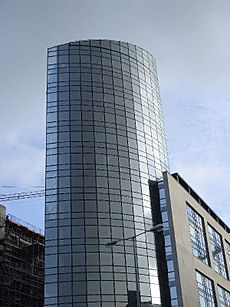
Limerick is in the "Midwest" or "Shannon Region" of Ireland. This area includes County Limerick, County Clare, and parts of other counties. Its economy is centered around Limerick city.
The University of Limerick, Limerick Institute of Technology, Shannon Airport, and Shannon Development have all helped the city's economy grow. Limerick Chamber of Commerce, a group for local businesses, has been around for over 200 years. In 2015, Limerick had one of the highest disposable incomes per person in Ireland, after Dublin.
Historically, Limerick's economy was based on farming and trade. Its port on the River Shannon was important for exporting farm products from the Golden Vale. The city was known for its bacon industry, including Limerick ham, but this declined in the mid-1900s. The fishing industry also declined.
Today, many international companies have offices in Limerick. Dell used to have a large manufacturing plant here. While the manufacturing moved to Poland, Dell still employs over 1,000 people in service and support. Analog Devices and Johnson & Johnson (Vistakon) also have large facilities in Limerick, employing many people. Cook Medical, a medical devices company, employs over 800 people.
The economic downturn after 2008 affected Limerick, with job losses, especially after Dell's manufacturing plant closed.
Shopping and Markets
The Crescent Shopping Centre in Dooradoyle is the largest shopping center in Munster. It has over 90 shops, restaurants, and a cinema. The city center also has many shops, especially on Cruises Street, O'Connell Street, and William Street.
The The Milk Market in the city center sells local foods and products. In 2010, it was redeveloped with a large roof so it can be used all year round.
Getting Around Limerick: Transport Options
Air Travel
Shannon Airport is 20 km west of Limerick in County Clare. It's one of Ireland's main airports with flights to Europe and North America. You can get there from Limerick using the N18 road and the Limerick Tunnel.
Bus Services
Bus Éireann, Ireland's state bus company, provides local and intercity bus services. They have routes around Limerick city and to towns and villages in the county. You can also take intercity buses from Limerick Colbert railway station to places like Dublin, Cork, and Galway.
Private bus companies like Dublin Coach and JJ Kavanagh also offer services from Limerick to Dublin. Citylink runs services to Galway and Cork.
Train Services
Iarnród Éireann's Limerick Colbert station is the main train hub for the city. It has services to many places:
- Limerick to Dublin Heuston: Many daily services, some direct.
- Limerick to Waterford: Two daily services (except Sundays).
- Limerick to Galway: Five daily services. This route reopened in 2010.
- Limerick to Cork: You can travel via Limerick Junction.
- Limerick to Killarney and Tralee: Also via Limerick Junction.
There are also local train services in the Limerick Suburban Rail network to Ennis, Nenagh, and Thurles.
Road Network
Limerick is a central point for many national roads. The M7 (to Dublin), N/M18 (to Galway), N/M20 (to Cork), N21 (to Tralee), and N24 (to Waterford) all meet near the city. The Limerick Tunnel helps bypass the city center. Roads to other cities have been improved, like the M7 motorway. A new motorway to Cork is also planned.
Water Transport
Water transport has always been important for Limerick. The Vikings used the River Shannon for trade. In the 1700s, Limerick Port became a major commercial port due to the river and canals. Goods were transported from Limerick to Dublin by water. Today, the Shannon Foynes Port handles all shipping in the Shannon estuary.
Learning in Limerick: Education Centers
Limerick is a big center for higher education. It has several colleges and universities with over 20,000 students.
The University of Limerick (UL) has over 17,000 students. It's about 5 km east of the city center. UL was founded in 1972 and became a university in 1989. It offers courses in engineering, IT, science, arts, and teacher education. UL has a medical school and is home to the Irish Chamber Orchestra. The campus also has an Olympic-standard swimming pool and "The Living Bridge," one of Europe's longest footbridges.
Limerick Institute of Technology (LIT) has about 7,000 students. It offers courses in business, engineering, IT, science, and art. In 2021, LIT joined with Athlone IT to become the Technological University of the Shannon: Midlands Midwest. Its main campus is at Moylish Park, and the Limerick School of Art and Design is in the city center.
Mary Immaculate College focuses on training primary school teachers. It is part of the University of Limerick.
Griffith College Limerick is a private college offering courses in business, law, and computing.
Limerick also has many primary and secondary schools. The Limerick and Clare Education and Training Board provides education for over 25,000 students. There are both co-educational (boys and girls) and single-sex (boys-only or girls-only) secondary schools in the city.
Sports in Limerick: A City of Champions
Rugby, Gaelic football, hurling, and association football are very popular in Limerick. The city also has clubs for tennis, athletics, cricket, and golf. Limerick hosts many big sporting events. In 2011, it was named a European City of Sport.
Former World Boxing Champion, Andy Lee, trained in Limerick.
Basketball
Basketball was very popular in Limerick in the 1970s and 1980s. Today, Limerick is represented in the National Leagues by the men's UL Eagles and women's UL Aughinish teams. They play their games at the University Arena.
Gaelic Games
Ireland's national sports, hurling and Gaelic football, are widely played. The Limerick county hurling team is very successful, having won the All-Ireland Senior Hurling Championship many times, including the last four in a row.
Several city clubs play hurling and football at different levels. Secondary schools also compete in major championships like the Dr. Harty Cup. The University of Limerick and Limerick Institute of Technology have also won the Fitzgibbon Cup for hurling.
Limerick's home venue for both sports is the Gaelic Grounds, which can hold 49,000 fans.
Golf
There are three golf clubs in Limerick: Limerick Golf Club, Castletroy Golf Club, and Rathbane Golf Club. Limerick Golf Club has won the Irish Senior Cup four times.
The JP McManus Invitational Pro-Am, a big golf event that raises money for charity, has been hosted near Limerick.
Rugby
Rugby union is extremely popular in Limerick, which is sometimes called the "spiritual home of Irish rugby." Two-time European champions Munster play most of their home games at Thomond Park. They had a long unbeaten record there in the Heineken Cup. Munster famously beat the All Blacks in 1978 at Thomond Park.
Limerick city teams have often won the All-Ireland League. These clubs include Shannon, Garryowen, and Young Munster.
Many secondary schools in Limerick compete in the Munster Schools Senior and Junior Cups. Crescent College and St Munchin's College are very successful rugby schools.
Football (Soccer)
Association football is also popular. The city was represented by Limerick FC in the League of Ireland. They won two league championships and two FAI Cups. The club played at Markets Field. After financial difficulties, a new club called Treaty United F.C. was created. They have both men's and women's teams.
Horse Racing
Limerick Racecourse is located near the city at Patrickswell. It hosts both flat and National Hunt (jump) horse races throughout the year.
Limerick's Sister Cities
Limerick is twinned with several cities around the world:
 A Coruña, Spain
A Coruña, Spain Kansas City, United States
Kansas City, United States Limerick Township, United States
Limerick Township, United States Lowell, United States
Lowell, United States Quimper, France
Quimper, France Santa Clara, United States
Santa Clara, United States Spokane, United States
Spokane, United States
Images for kids
-
Sculpture by Antony Gormley in the Central Plaza of the University of Limerick
See also
 In Spanish: Limerick para niños
In Spanish: Limerick para niños




